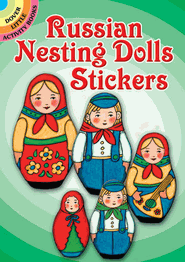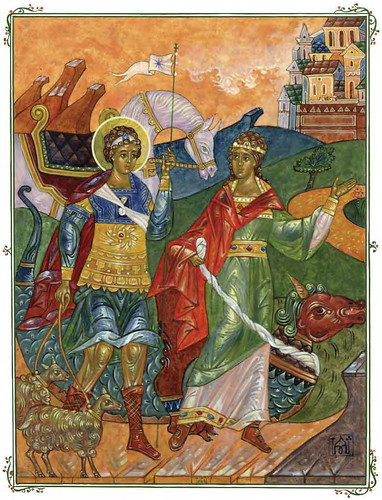You don't even have to pack a bag! My husband and I had the pleasure of travelling to St. Petersburg last December. It was a trip I will never forget, and I look forward to sharing some of my photos with you this week.
 |
| I found these luggage tags at Target!!! |
Have you heard of Dover Publications? I love the little sticker books! They're small format and VERY affordable at only $1.50. Besides the Nesting doll sticker book, I found an "Anastasia from Russia" sticker book pictured below with Look What Came From Russia, part of a series of books by Miles Harvey.
I have to admit that I was a bit surprised that Look What Came From Russia covered history, inventions, food, clothing, and art, but left out religion. Much of Russia's architecture, customs, celebrations, and history are steeped in the traditions of the Orthodox Church.
Many of the photos that I took during our visit to St. Petersburg were in beautiful churches, museums, and palaces - we saw beautiful byzantine iconography everywhere.
I'll be sharing pictures of churches we visited in another post - below are some of my photos from The Russian Museum in the Mikhailovsky Palace.
 |
| Our first day touring around St. Petersburg was bright and sunny (but COLD!) |
We saw very traditional Russian paintings...
current day art,
and some modern artwork...
We also saw the art of one of my favorite Russian artists, Mikhail Nesterov. I was so excited to see his beautiful art in person. From the Museum website: "The creative oeuvre of Mikhail Nesterov (1862-1942) that was connected with religious and philosophic searches of the so-called Silver Age of the Russian culture revealed to a viewer the wonderful poetical world of the Orthodox monasteries and Old-believing cells, fascination of the nature of Middle Russia and the inspired beauty of the national character."
Below is a painting that Nesterov did of the Monk Sergius, who became St. Sergius of Radonezh. Nesterov's most famous painting was Vision of the Young Bartholomew. It features Sergius as a young boy (his name was Bartholomew before he became a monk). You can read my blog post with his story and see that painting, here.
 |
| "St. Sergius of Radonezh" |
Inspiration was found on the banks of the cold sea for Nesterov's next well-know work: Holy Russia. The painting was exhibited in 1902 in Kiev. It depicts Jesus Christ surrounded by pilgrims, standing against a winter landscape.
 |
| "Holy Russia" |
The sad painting below shows Tsarevitch Dmitry, Ivan IV the Terrible's youngest son, thought to have been killed while still a child by Boris Godunov (who allegedly wanted to get rid of the last heir to the throne and ascend it himself). It was never proved, but people blamed Boris. Nesterov depicted the tsarevich as an innocent child in a very emotional and mysterious portrait. God is looking down upon him and blesses his soul from above. Can you see the image of Christ in the upper left-hand corner of the painting?
 |
| "Tsarevitch Dmitry" |
More about my travels to St. Petersburg soon...I hope you stop by again!













































